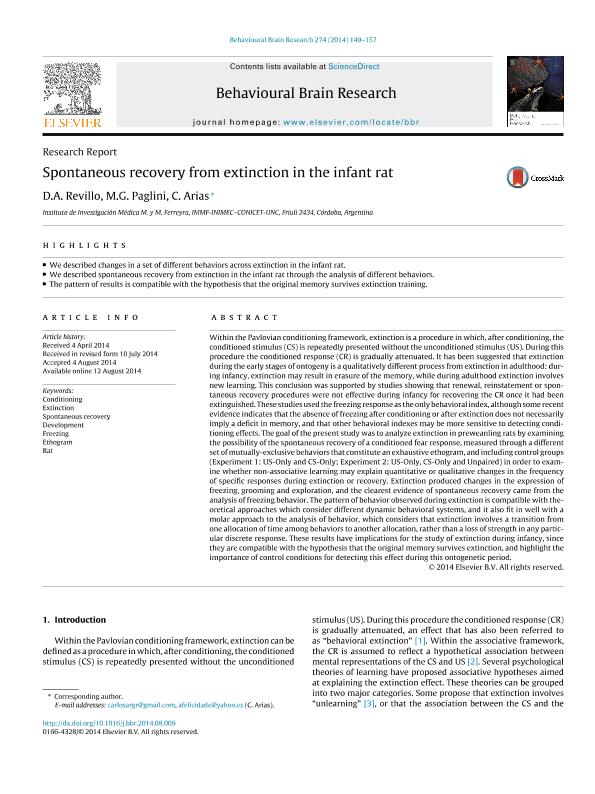Mostrar el registro sencillo del ítem
dc.contributor.author
Revillo, Damian Alejandro

dc.contributor.author
Paglini, Maria Gabriela

dc.contributor.author
Arias Grandio, Carlos

dc.date.available
2017-12-27T14:08:05Z
dc.date.issued
2014-11
dc.identifier.citation
Arias Grandio, Carlos; Paglini, Maria Gabriela; Revillo, Damian Alejandro; Spontaneous recovery from extinction in the infant rat; Elsevier Science; Behavioural Brain Research; 274; 11-2014; 149-157
dc.identifier.issn
0166-4328
dc.identifier.uri
http://hdl.handle.net/11336/31629
dc.description.abstract
Within the Pavlovian conditioning framework, extinction is a procedure in which, after conditioning, the conditioned stimulus (CS) is repeatedly presented without the unconditioned stimulus (US). During this procedure the conditioned response (CR) is gradually attenuated. It has been suggested that extinction during the early stages of ontogeny is a qualitatively different process from extinction in adulthood: during infancy, extinction may result in erasure of the memory, while during adulthood extinction involves new learning. This conclusion was supported by studies showing that renewal, reinstatement or spontaneous recovery procedures were not effective during infancy for recovering the CR once it had been extinguished. These studies used the freezing response as the only behavioral index, although some recent evidence indicates that the absence of freezing after conditioning or after extinction does not necessarily imply a deficit in memory, and that other behavioral indexes may be more sensitive to detecting conditioning effects. The goal of the present study was to analyze extinction in preweanling rats by examining the possibility of the spontaneous recovery of a conditioned fear response, measured through a different set of mutually-exclusive behaviors that constitute an exhaustive ethogram, and including control groups (Experiment 1: US-Only and CS-Only; Experiment 2: US-Only, CS-Only and Unpaired) in order to examine whether non-associative learning may explain quantitative or qualitative changes in the frequency of specific responses during extinction or recovery. Extinction produced changes in the expression of freezing, grooming and exploration, and the clearest evidence of spontaneous recovery came from the analysis of freezing behavior. The pattern of behavior observed during extinction is compatible with theoretical approaches which consider different dynamic behavioral systems, and it also fit in well with a molar approach to the analysis of behavior, which considers that extinction involves a transition from one allocation of time among behaviors to another allocation, rather than a loss of strength in any particular discrete response. These results have implications for the study of extinction during infancy, since they are compatible with the hypothesis that the original memory survives extinction, and highlight the importance of control conditions for detecting this effect during this ontogenetic period.
dc.format
application/pdf
dc.language.iso
eng
dc.publisher
Elsevier Science

dc.rights
info:eu-repo/semantics/openAccess
dc.rights.uri
https://creativecommons.org/licenses/by-nc-sa/2.5/ar/
dc.subject
Conditioning
dc.subject
Extinction
dc.subject
Spontaneous Recovery
dc.subject
Development
dc.subject
Freezing
dc.subject
Ethogram
dc.subject
Rat
dc.subject.classification
Psicología

dc.subject.classification
Psicología

dc.subject.classification
CIENCIAS SOCIALES

dc.title
Spontaneous recovery from extinction in the infant rat
dc.type
info:eu-repo/semantics/article
dc.type
info:ar-repo/semantics/artículo
dc.type
info:eu-repo/semantics/publishedVersion
dc.date.updated
2017-12-26T20:39:10Z
dc.journal.volume
274
dc.journal.pagination
149-157
dc.journal.pais
Países Bajos

dc.journal.ciudad
Amsterdam
dc.description.fil
Fil: Revillo, Damian Alejandro. Consejo Nacional de Investigaciones Científicas y Técnicas. Centro Científico Tecnológico Conicet - Córdoba. Instituto de Investigación Médica Mercedes y Martín Ferreyra. Universidad Nacional de Córdoba. Instituto de Investigación Médica Mercedes y Martín Ferreyra; Argentina
dc.description.fil
Fil: Paglini, Maria Gabriela. Consejo Nacional de Investigaciones Científicas y Técnicas. Centro Científico Tecnológico Conicet - Córdoba. Instituto de Investigación Médica Mercedes y Martín Ferreyra. Universidad Nacional de Córdoba. Instituto de Investigación Médica Mercedes y Martín Ferreyra; Argentina
dc.description.fil
Fil: Arias Grandio, Carlos. Consejo Nacional de Investigaciones Científicas y Técnicas. Centro Científico Tecnológico Conicet - Córdoba. Instituto de Investigación Médica Mercedes y Martín Ferreyra. Universidad Nacional de Córdoba. Instituto de Investigación Médica Mercedes y Martín Ferreyra; Argentina
dc.journal.title
Behavioural Brain Research

dc.relation.alternativeid
info:eu-repo/semantics/altIdentifier/url/http://www.sciencedirect.com/science/article/pii/S016643281400521
dc.relation.alternativeid
info:eu-repo/semantics/altIdentifier/doi/http://dx.doi.org/10.1016/j.bbr.2014.08.009
Archivos asociados
